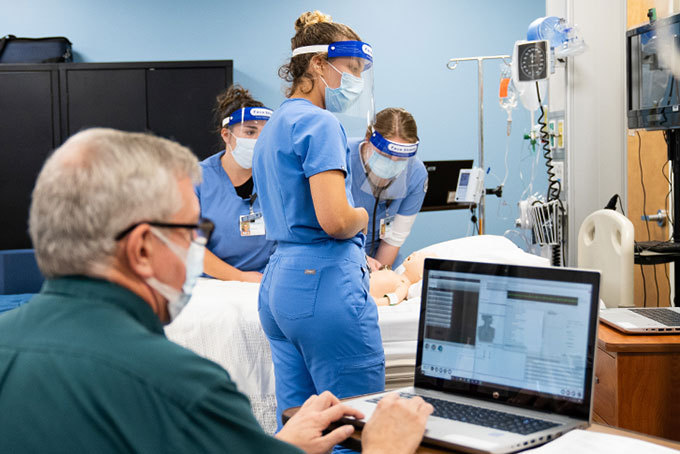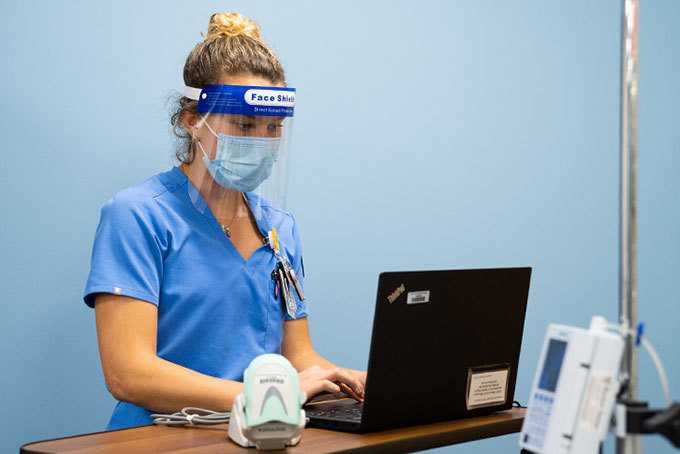Brenna Hopkins ’22 comforted the crying infant while Shelby Kanter ’22 put in a call to his provider.
The patient, 4-month-old Ricky Tundra, was admitted earlier in the day with a cough and a slight fever, and his team of caretakers were growing concerned with changes to his vital signs.
With his provider on the phone and Ricky coughing in the background, the team’s third member, Rachel Ferrier ’22, carefully read off their patient’s blood pressure, temperature and oxygen levels to Kanter, who relayed the information to the voice on the other end of the line. Moments later, a prescription was delivered to Ricky’s bedside and was methodically administered by the team.
“Great job. That’s it,” said Adjunct Professor Katelyn Cormier, MSN, RN, prompting others in Colby-Sawyer College’s Mercer nursing laboratory to applaud.

Visibly relieved, Hopkins, Kanter and Ferrier congratulated one another before joining the rest of their classmates to debrief.
“It feels real,” said Ferrier, a member of the Wesson Honors Program and women’s soccer team. “Once the simulation starts, you become immersed in what’s going on and so it feels very real. As Ricky’s vitals became concerning, I could feel myself having a stress reaction that I would have with a live patient. You also experience genuine relief when the patient begins to stabilize and the simulation ends.”
The exercise was one of a variety of simulations that all students enrolled in Colby-Sawyer’s Bachelor of Science in Nursing program are required to take part in. Run in conjunction with Dartmouth-Hitchcock Health (D-HH), a strategic partner of the college for more than 40 years, simulations are conducted using state-of-the-art technology that allow faculty to replicate virtually any clinical scenario.
For Hopkins, Kanter and Ferrier, the exercise was a pediatric simulation, in which they were told only that they’d be caring for an infant patient in respiratory distress. As third-year nursing students, they’ll participate in three additional simulations before the end of their second semester.

“Our main goal is for students to enhance the application of their knowledge through these scenarios,” said Assistant Professor Nicole Chartier, MSN, RN, who, along with Cormier, also works at Dartmouth-Hitchcock Medical Center (DHMC) in nearby Lebanon, N.H., in the Intensive Care Nursery. “We want them to learn how to work together as a team, ask for help and communicate effectively to ensure safe patient care.”
D-HH has been conducting simulations for Colby-Sawyer students since 2008. But unlike previous years in which the majority of simulations are held at the Patient Safety Training Center (PSTC) at DHMC, restrictions put in place due to COVID-19 have forced most simulations to be relocated to the college. Fortunately, the transition has been seamless, as Colby-Sawyer is home to two nursing labs designed to the specifications of a typical hospital inpatient nursing unit – complete with Hill-Rom adjustable beds, IV pumps and wall-mounted oxygen connections.
During the pediatric simulation, students worked in small groups on one side of the lab administering care to a pediatric patient simulator so life-like, its operator could change its skin tone to reflect changes in its oxygen levels. Across the room, a Dartmouth-Hitchcock PTSC technician controlled the pediatric patient simulator’s vital signs and bodily functions through a laptop, while nearby, the course’s nursing faculty and the rest of the class watched a live video feed of the action.

“The simulations are created by faculty members and the simulation experts at Dartmouth-Hitchcock,” said Chartier, adding that all nursing clinical courses have a simulation component. “They are updated using the latest evidence-based practice, which is critical for nursing students to learn and understand as they complete their clinical rotations.”
Matthew Charnetski, director of simulation based education and research at D-HH, said it’s not only the Colby-Sawyer students who benefit from the experience and knowledge gained during simulations.
“The more experience students have as they start clinical, the easier they are to work with as they begin to rotate through our facilities,” Charnetski explained. “This has the potential to lower the workload and mental energy cost on our nurses working with students. We are also creating a workforce that’s better and more comprehensively prepared to work at Dartmouth-Hitchcock.”
Charnetski and his team are tasked with supporting the experiential educational needs of D-HH and its partners like Colby-Sawyer. He and his team work closely with educators, patient safety specialists and others to define their educational needs and meet them through creative and, often, innovative means like simulations.
“We allow learners to practice in this high-frequency, low-consequence environment,” Charnetski said. “By having the opportunity to fail early and fail often without any real functional consequence (no patients were harmed in the making of this simulation), we can provide direct observation, feedback and debriefing to best assist our learners. Being able to iteratively practice literally anything, we can create a volume of experiences that might take years to develop, particularly in uncommon or highly acute situations.”
Ferrier agreed, and admitted that while simulations may not be her favorite part of the nursing curriculum, there’s no denying their value.
“Being able to make mistakes in these simulations without the consequence of harming a living patient is incredibly helpful,” she said. “We learn the most from our mistakes and it’s important that we learn without compromising the quality of a patient’s care.”
During the debriefing process, Hopkins, Kanter and Ferrier reflected on their decision making, and listened to feedback from both their instructors and classmates. Chartier complimented the students for working well together as a team, and highlighted something unique each brought to the table.
For Hopkins, it was her constant reassessment of the patient’s condition that drew praise from her instructor. Kanter was credited for her situational awareness and ability to see the big picture. And Ferrier was applauded for her critical thinking amid stressful, ever-changing circumstances.
“I absolutely feel more comfortable working with living patients and handling stressful situations after having participated in these simulations,” Ferrier said. “In clinical, nursing students will never be in charge of leading or handling a stressful situation – we are only permitted to observe or follow instructions from the nurse in charge. Simulations allow us to practice leading and handling stressful situations, making us more prepared for when we become working nurses.”